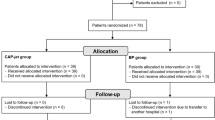Abstract
This study was undertaken to investigate the efficacy of ultra-low microcurrent delivered by the Electro Pressure Regeneration Therapy (EPRT) device for the management of chronic wounds. In this study, 23 patients with chronic skin ulcers and 2 with abdominal dehiscence that was present for an average of 16.5 mo, who were not responsive to standard conservative treatment in a hospital setting, were treated with the EPRT device. Wounds were treated with direct current (maximum of 3 mA) of 1 polarity for 11.5 min and then with a current of the opposite polarity for another 11.5 min. Treatment was applied through ultra-low microcurrents (in the mA to nA range) conducted through special wraps applied above and below the wound. The results revealed that 34.8% of cases achieved complete wound healing after an average of 45.6 h of treatment, and 39.1 % achieved ≥50% healing after an average of 39.7 h of treatment. Several patients achieved significant results after 1 to 2 treatments. The EPRT device not only accelerated healing but also appeared to negate the effect of a person’s age on wound healing.
Similar content being viewed by others
References
Alvarez M, Mertz M, Smerbeck V, Eaglstein H. The healing of superficial skin wounds is stimulated by external electrical current.J Invest Dermatol. 1983;81:144–148.
Brown M, McDonnel M, Menton D. Electrical stimulation effects on cutaneous wound healing in rabbits.Phys Ther. 1988;68:955–960.
Weiss DS, Eaglstein WH, Falanga V. Exogenous electric current reduces the formation of hypertrophic scars.J Dermatol Surg Oncol. 1989;15:1272–1275.
Bogie KM, Reger SI, Levine SP, Sahgal V. Electrical stimulation for pressure sore prevention and wound healing.Assist Technol. 2000;12:50–66.
Demir H, Balay H, Kirnap M. A comparative study of the effects of electrical stimulation and laser treatment on experimental wound healing in rats.J Rehabil Res Dev. 2004;41:147–154.
Baker LL, Rubayi S, Villar F, Demuth SK. Effect of electrical stimulation waveform on healing of ulcers in human beings with spinal cord injury.Wound Repair Regen. 1996;4:21–28.
Bach S, Bilgrav K, Gottrup F, Jorgensen TE. The effect of electrical current on healing skin incision: an experimental study.Eur J Surg. 1991;157:171–174.
Carley PJ, Wainapel SF. Electrotherapy for acceleration of wound healing: low intensity direct current.Arch Phys Med Rehabil. 1985;66:443–446.
Nessler JP, Mass DP. Direct-current stimulation of tendon healing in vitro.Clin Orthop Relat Res. 1987;217:303–312.
Fleischi G, Lauchlin T. Electrical stimulation in wound healing.J Foot Ankle Surg. 1977;36:457–461.
Takaoka Y, Ohta M, Ito A, et al. Electroacupuncture suppresses myostatin gene expression: cell proliferative reaction in mouse skeletal muscle.Physiol Genomics. 2007;30:102–110.
Tan G, Rintala DH, Thornby JI, Yang J, Wade W, Vasilev C. Using cranial electrotherapy stimulation to treat pain associated with spinal cord injury.J Rehabil Res Dev. 2006;43:461–474.
Lichtbroun AS, Raicer MM, Smith RB. The treatment of fibromyalgia with cranial electrotherapy stimulation.J Clin Rheumatol. 2001;7:72–78.
El-Husseini T, El-Kawy S, Shalaby H, El-Sebai M. Microcurrent skin patches for postoperative pain control in total knee arthroplasty: a pilot study.Int Orthop. 2007;31:229–233.
Mäenpää H, Jaakkola R, Sandström M, Von Wendt L. Does microcurrent stimulation increase the range of movement of ankle dorsiflexion in children with cerebral palsy?Disabil Rehabil. 2004;26:669–677.
King GE, Scheetz J, Jacob RF, Martin JW. Electrotherapy and hyperbaric oxygen: promising treatments for postradiation complications.J Prosthet Dent. 1989;62:331–334.
Lennox AJ, Shafer JP, Hatcher M, Beil J, Funder SJ. Pilot study of impedance-controlled microcurrent therapy for managing radiation-induced fibrosis in head- and-neck cancer patients.Int J Radiat Oncol Biol Phys. 2002;54:23–34.
Lambert MI, Marcus P, Burgess T, Noakes TD. Electro-membrane microcurrent therapy reduces signs and symptoms of muscle damage.Med Sci Sports Exerc. 2002;34:602–607.
Bertolucci LE, Grey T. Clinical comparative study of microcurrent electrical stimulation to mid-laser and placebo treatment in degenerative joint disease of the temporomandibular joint.Cranio. 1995;13:116–120.
Allen JD, Mattacola CG, Perrin DH. Effect of microcurrent stimulation on delayed-onset muscle soreness: a double-blind comparison.J Athl Train. 1999;34:334–337.
AL-Waili N. Electrotherapy for chronic gum and periapical abscesses.J Pak Med Assoc. 1989;39: 161–162.
Song B, Zhao M, Forrester V, McCaig D. Electrical cues regulate the orientation and frequency of cell division and the rate of wound healing in vivo.Proc Natl Acad Sci USA. 2002;99:13577–13582.
McCaig D, Rajnicek M, Song B, Zhao M. Has electrical growth cone guidance found its potential?Trends Neurosci. 2002;25:354–359.
Zhao M, Bai H, Wang E, Forrester V, McCaig D. Electrical stimulation directly induces preangiogenic response in vascular endothelial cells by signaling through VEGF receptors.J Cell Sci. 2003;117:397–405.
Cheng N, Van Hoof F, Bockx E, et al. The effects of electric currents on ATP generation, protein synthesis, and membrane transport in rat skin.Clin Orthop Relat Res. 1982;171:264–272.
Todd I, Clothier RH, Huggins ML, et al. Electrical stimulation of transforming growth factorbeta 1 secretion by human dermal fibroblasts and the U937 human monocytic cell line.Altern Lab Anim. 2001;29:693–701.
Denegar CD, Pernin DH, Rogol A, Rutt R. Influence of transcutaneous electrical nerve stimulation on pain, range of motion, and serum cortisol concentration in females experiencing delayed onset muscle soreness.J Orthop Sports Phys Ther. 1989;1:100–103.
Wlaschek M, Scharffetter-Kochanek K. Oxidative stress in chronic venous leg ulcers.Wound Repair Regen. 2005;13:452–461.
Haddad JJ, Saadé NE, Safieh-Garabedian B. Redox regulation of TNF-alpha biosynthesis: augmentation by irreversible inhibition of gammaglutamylcysteine synthetase and the involvement of an IkappaB-alpha/NF-kappaB-independent pathway in alveolar epithelial cells.Cell Signal. 2002;14:211–218.
Haddad JJ. Redox regulation of pro-inflammatory cytokines and IkappaB-alpha/NF-kappaB nuclear translocation and activation.Biochem Biophys Res Commun. 2002;296:847–856.
Author information
Authors and Affiliations
Corresponding author
Rights and permissions
About this article
Cite this article
Lee, B.Y., Wendell, K., Al-Waili, N. et al. Ultra-low microcurrent therapy: A novel approach for treatment of chronic resistant wounds. Adv Therapy 24, 1202–1209 (2007). https://doi.org/10.1007/BF02877766
Issue Date:
DOI: https://doi.org/10.1007/BF02877766




